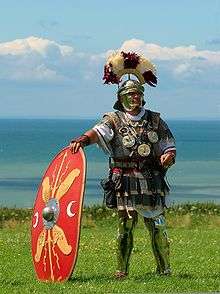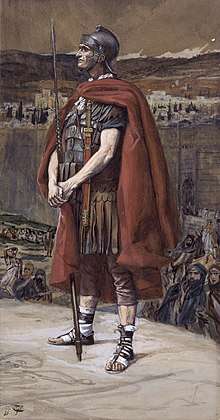Centurion
A centurion (/sɛnˈtjʊəriən/; Latin: centurio; Greek: κεντυρίων, kentyríōn or ἑκατόνταρχος, hekatóntarkhos) was a professional officer of the Roman army after the Marian reforms of 107 BC. Centurions commanded a century of around 80 legionaries. The centuries (centuriae) commanded by the centurion theoretically derive from centum ("hundred"),[1] but that connection is now disputed.[2][3][4] It certainly meant "company" or "tribe",[1] but senior centurions commanded cohorts or took senior staff roles in their legion. Centurions were also found in the Roman navy. In the Byzantine Army, they were also known by the name kentarch (κένταρχος, kentarchos).[5] Their symbol of office was the vine staff, with which they disciplined even Roman citizens protected from other forms of beating by the Porcian Laws.

Role

In the Roman infantry, the centurions initially commanded a centuria or "century". Centuries developed from the Roman tribal system under the Servian reforms and could contain 200 to 1,000 legionaries. Later, generals and emperors further manipulated these numbers with double and half-strength units. Julius Caesar, for instance, made the first cohort of 5 double strength centuries.
Centurions received a much higher rate of pay than the average legionary.[6] Veteran legionaries often worked as tenants of their former centurions.[7]
During the Imperial era, centurions gradually rose in seniority in their cohort, commanding centuries with higher precedence, until commanding the senior century and therefore the whole cohort. The best centurions were then promoted to the First Cohort, called Primi Ordines, commanding one of the ten centuries and also taking on a staff role. The most senior centurion of the legion was the Primus Pilus who commanded the first century. All centurions, however senior, had their own allocated century. There was little difference between the ranks of centurions except for the Primus Pilus, who also participated in war councils.[8] The Primus Pilus was so called because his own century was the first file of the first (rightmost) cohort. Only eight officers in a fully officered legion outranked the Primus Pilus: the legate (legatus legionis), commanding the legion; the senior tribune (tribunus laticlavius), second-in-command of the legion; the Camp Prefect (praefectus castrorum); and the five other tribunes (tribuni angusticlavii) who served as senior staff officers to the legate with a rank roughly equivalent to a modern Colonel.
Comparisons between the centurion grades and modern officer ranks can lead to many incorrect assumptions. Centurions could be elected, appointed by the Senate, or promoted from the ranks for a variety of reasons.[4] Julius Caesar is said to have promoted his centurions for displays of valor. Historians cite examples of them being the first over the enemy's wall or through the breach.[3] The various centurion grades may be loosely compared to modern junior and middle officer grades.[9][10] A modern captain is typically in command of roughly 200 men, and a centurion would typically have command over a company of similar size. Below the centurions were the optiones, seconds-in-command of centuries.
Centurions were held personally responsible for the training and discipline of the legionaries under their command, and they had a reputation for dealing out harsh punishment. Tacitus tells a story in The Annals of a centurion known as "Cedo Alteram", which roughly translates to "Fetch Me Another". "The mutinous soldiers thrust out the tribunes and the camp-prefect; they plundered the baggage of the fugitives, and then killed a centurion, Lucilius, to whom, with soldier's humour, they had given the nickname 'Cedo Alteram', because when he had broken one vine-stick across a soldier's back, he would call in a loud voice for another… and another...and another!" The vine-stick (vitis) was a symbol of the centurion's authority and the implement with which he meted out punishment.
Unlike Legionnaires, the Roman Centurions carried their swords (ensis) on their left side as a sign of distinction[11] and carried the pugio (dagger) on the right, as the sidearm.
Centurions often had important social status and held powerful positions in society. They seem to have received their status according to their rank.[12] On retirement, they could be eligible for employment as lictors.[13]
Seniority

Each century had a precedence within the cohort. Centurions' seniority within the cohort and legion depended on the position within the legion of the century they were in charge of, which often took their name from their centurion. Centurions began by leading junior centuries before being promoted to leading a more senior one. Promotion usually came with experience, or at least length of service, but many still never made it as far as leading a 1st cohort. Yet for centurions who showed, say, particularly conspicuous bravery during battle, there was the opportunity to be promoted several grades at once. For example, Julius Caesar's reward for a centurion who had greatly pleased him was to advance him eight grades.[14] Promotion through the various grades often meant transferring to another legion.
The precedence during the times of the manipular legion, commanding sixty men, was organized like this:
- Hastati: Ten junior and ten senior
- Principes: Ten junior and ten senior
- Triarii: Five junior and five senior
For the imperial legion they were organized (in order of who advanced first);
- 1st cohort
- 2nd cohort
- 3rd cohort
- 4th cohort
and so on.
There were five centuries in the first cohort, each century with twice the number of soldiers of a normal century. All first-cohort centurions outranked all centurions from other cohorts.
The qualities necessary for the centurion
Centurions had to be literate (to be able to read written orders), have connections (letters of recommendation), be at least 30 years of age, and have already served a few years in the military. They also have had to be able to boost their soldiers' morale.
The centurion in the infantry is chosen for his size, strength and dexterity in throwing his missile weapons and for his skill in the use of his sword and shield; in short for his expertness in all the exercises. He is to be vigilant, temperate, active and readier to execute the orders he receives than to talk; Strict in exercising and keeping up proper discipline among his soldiers, in obliging them to appear clean and well-dressed and to have their weapons constantly rubbed and bright.
In the New Testament
Matthew's Gospel and Luke's Gospel[16] relate an incident in which a servant of a centurion based in Capernaum was ill. In the Gospel of Luke, the centurion concerned had a good relationship with the elders of the local Jewish population and had funded the development of the synagogue in Capernaum, and when he heard that Jesus was in the locality, he asked the Jewish elders to request healing for his servant. In the Gospel of Matthew, the centurion makes direct contact with Jesus. The stories report that Jesus marveled at his faith and restored his servant to health.
The Book of Acts[17] tells of a centurion named Cornelius whose righteous and generous acts find favor with God. The apostle Simon Peter is told in a vision to visit Cornelius, a Gentile, with whom association was not permitted under Jewish law. The encounter leads Simon Peter to understand that God accepts non-Jews who believe in God and repent. After this revelation, the message of Jesus was evangelized to the Gentiles.
See also
Historic centurions
- St Agathius
- St Alexander
- Aulus Pudens
- Cassius Chaerea
- St Cornelius
- Gaius Crastinus
- Gordius
- St Longinus
- Lucius Artorius Castus
- Lucius Vorenus
- St Marcellus
- Petronius
- Sempronius Densus
- Spurius Ligustinus
- Titus Pullo
- Verus
Related
- Primus pilus
- Vine staff
- List of Roman army unit types
- Military establishment of the Roman Empire
- Evocatus, related Roman rank
- Praefectus Castrorum
References
- New College Latin Dictionary
- The Roman Legions
- The Complete Roman Army
- The Roman War Machine
- Kazhdan, Alexander, ed. (1991). Oxford Dictionary of Byzantium. Oxford University Press. pp. 1120–1121. ISBN 978-0-19-504652-6.
- Earl S. Johnson, Jr., "Centurion," The New Interpreter's Dictionary of the Bible, Vol. 1; Nashville: Abingdon Press, 2006, p. 580. ISBN 9780687054275
- Rich, John. "Military Organization and Social Change." War and Society in the Roman World. Ed. Graham Shipley. Vol. 5. N.p.: n.p., 1993. N. pag. Print. Leicester-Notthingham Studies in Ancient Society
- "centurion." Encyclopædia Britannica. Encyclopædia Britannica Online Academic Edition. Encyclopædia Britannica Inc., 2012. Web. 17 Sep. 2012. <http://www.britannica.com/EBchecked/topic/102946/centurion>.
- Goldsworthy, A. (2003) Complete Roman Army pp.68–73
- Hoffman, B. (1995) The quarters of the legionary centurions of the Principate. Britannia 26; 107-151
- "Centurion". Ancient History Encyclopedia. Retrieved 2019-10-21.
- Justin R. Howell, The Imperial Authority and Benefaction of Centurions and Acts 10.34-43: A Response to C. Kavin Rowe., Page numbers of article p25-51, 27p, Journal for the Study of the New Testament, Vol. 31 Issue 1, Sep2008
- The Legions of Rome, Stephen Dando-Collins, pp41, Quercus (December 2010)
- The Legions of Rome, Stephen Dando-Collins, pp40, Quercus (December 2010)
- "Archived copy". Archived from the original on 2009-04-10. Retrieved 2009-05-10.CS1 maint: archived copy as title (link)
- Matthew 8:5-13; Luke 7:1-10
- Acts 10:1-11:30
External links

- . Encyclopædia Britannica. 5 (11th ed.). 1911.
- Centurion, illustrated article by Ross Cowan about the centurions of the Late Republic and Early Empire